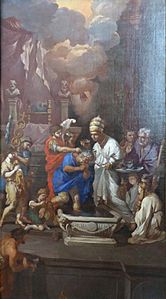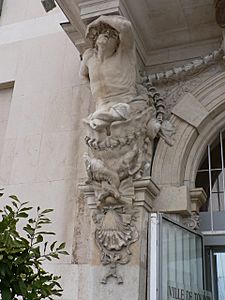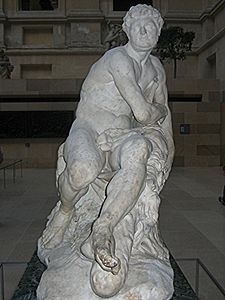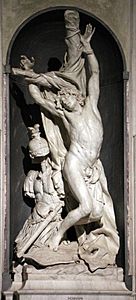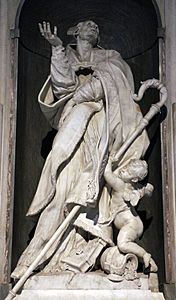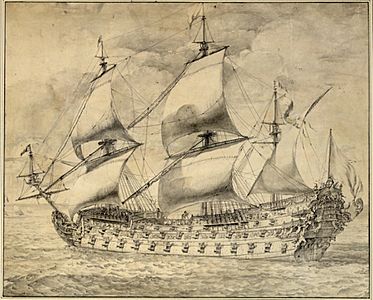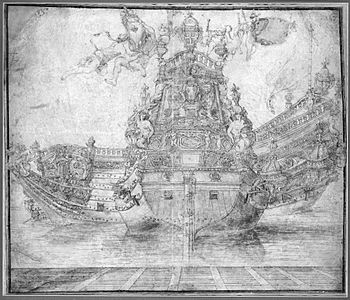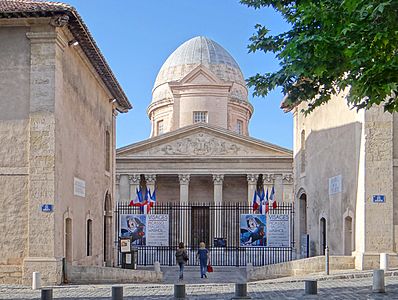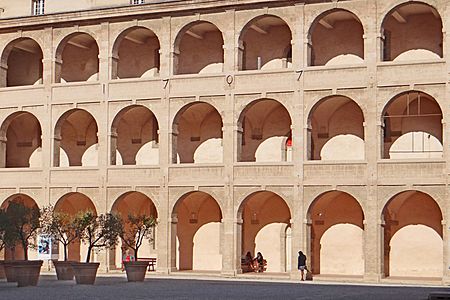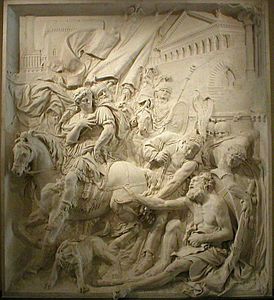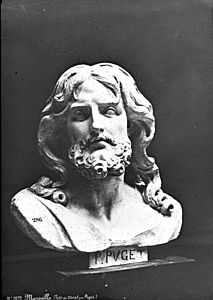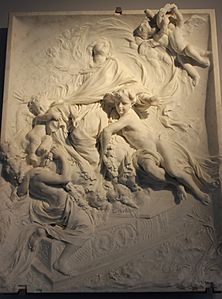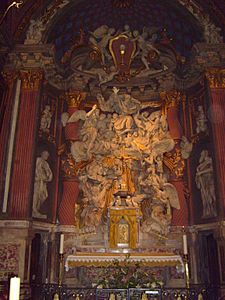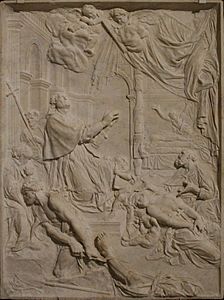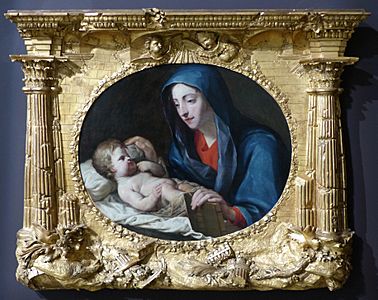Pierre Puget facts for kids
Quick facts for kids
Pierre Puget
|
|
|---|---|
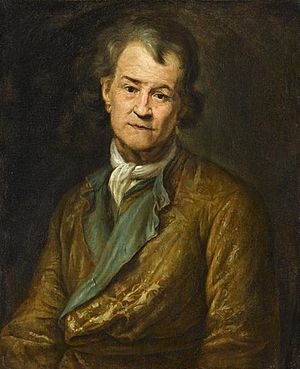
Pierre Paul Puget, by his son François Puget
|
|
| Born | 16 October 1620 |
| Died | 2 December 1694 (aged 74) Marseille
|
| Nationality | French |
| Known for | Sculpture, painting, architecture |
| Movement | Baroque style |
Pierre Paul Puget (born October 16, 1620 – died December 2, 1694) was a talented French artist. He was a Baroque painter, sculptor, architect, and engineer. Puget's sculptures were known for showing strong feelings and drama. This made his art stand out from other sculptures of his time.
Life Story of Pierre Puget
Pierre Paul Puget was born in Marseille, France, on October 16, 1620. His father was a stone mason. Pierre started his career very young, at just 14 years old. He began by carving fancy wooden decorations for ships in Marseille. He also showed a gift for painting.
Starting in Italy
In 1640, when he was 18, Puget traveled to Italy. He went to Livorno and then Florence, looking for work as a carver or painter. He carved some decorations in Florence. Then, with good recommendations, he went to Rome. There, he met Pietro da Cortona, a famous Baroque painter. Puget helped Da Cortona paint beautiful ceilings in grand palaces like the Palazzo Barberini in Rome and the Palazzo Pitti in Florence.
Working in Marseille and Toulon
After three years in Rome, Puget returned to Marseille. He brought with him the exciting Baroque style from Italy. He had drawn many detailed designs of Italian ships. He showed these to the Grand Admiral of the French fleet. Puget was then asked to design a carved medallion for a new French warship.
After the Admiral died in 1646, Puget started painting more. He mostly painted religious scenes. He also designed public fountains for new squares in Toulon in 1649. In 1652, he made baptismal fonts for the Marseille cathedral. From 1662 to 1665, he painted several works for the same cathedral.
Puget was recognized as a painter, but he didn't earn much money. For two large paintings in 1653, he received a very small amount. He painted 56 works in total. In 1665, he became very ill. Doctors advised him to stop painting completely.
In 1650, Puget was living in Toulon and got married there. He then focused all his energy on sculpture. In 1655, he got his first big sculpture job. He was to decorate the entrance of the Toulon town hall. He created a porch held up by strong, muscular figures called atlantes. These figures are still there today. He used real dock workers as models for their powerful bodies. The sculptures showed their struggle with the heavy weight. This work was finished in 1657. Puget was paid well for it, and the city was very happy. Copies of his work were made and shared. This project turned Puget from a painter into a famous sculptor.
Working for Nobles and in Genoa
Puget's fame grew beyond his home region. He was invited to Paris and received a job from a nobleman named Girardin. He made two statues for a castle in Normandy. He finished them in Paris in 1660.
Then, he got an even bigger job from Nicolas Fouquet, the King's Minister of Finance. Fouquet wanted sculptures for his new garden at Vaux-le-Vicomte. One statue was of Hercules, Fouquet's personal symbol. These statues were to be made of marble, which was very expensive. Fouquet sent Puget to Genoa, Italy, to choose the best marble blocks himself. While preparing for his trip, Puget turned down other offers from Jean-Baptiste Colbert, a powerful government official. Colbert did not forget this.
In 1660, Puget went to the Carrara marble quarries. He chose the marble he wanted and picked a sailor from Genoa as a model. In Genoa, he created the statue known as the Hercules of Gaul. However, in 1661, Fouquet was arrested. Colbert accused him of misusing government money. The Hercules statue meant for Fouquet's garden was later sent to Colbert's home. It is now in the Louvre Museum.
Puget decided to stay in Italy for a while. He visited Rome and Genoa often. His main supporter there was an Italian nobleman, Francesco Maria Sauli. Puget's most important works during this time were two large statues for the church of Santa Maria di Carignano. They showed Saint Sebastian and Bishop Alexander Paoli. These were finished in 1663 and showed the influence of another famous sculptor, Bernini. He also made a notable statue called The Immaculate Conception.
-
Saint Sebastian at Santa Maria Assunta, Genoa (1668)
Puget returned to France in 1669. He split his time between Toulon and Marseille. He was offered the job of chief decorator for French warships. But he had many demands for Colbert, including being treated as an officer, not just a worker. He also wanted to have the final say on designs, even over the King's official artists. Colbert found this unacceptable. As a result, another sculptor, François Girardon, got the job to decorate the main new warship, the Royal Louis.
Puget continued to work on other art projects in Toulon. He sculpted a large marble group of the Virgin and Child for a church. He also created a huge wooden altar piece for Toulon Cathedral, which is still there. In addition, he designed houses in Aix-en-Provence and several public buildings in Marseille. These included the fish market, which is still used today, and La Vieille Charité. This building was originally a home for the poor and is now a cultural center.
Puget's ideas for ship design soon clashed with a new official, Chevalier de Clairville. Clairville changed all of Puget's plans. He removed decorations he thought were unnecessary. Puget complained to Colbert, but Colbert supported Clairville. At the end of 1669, Puget left the dockyards and went back to Genoa. There, he created more works, including The Virgin (1670).
When he returned to the dockyards in 1670, he found that others were finishing the ship decorations he had started. He also learned that Colbert now required all his work to be approved by artists in Paris. Puget was only allowed to design what he was told. Colbert also argued that British ships had little decoration and often won battles. So, French ships should also be plain.
Architecture and City Design in Marseille
In 1672, with no more work at the Naval Arsenal, Puget returned to Marseille. His first project was a new city square and street. He got many ideas from the city planning in Genoa. He also created a fancy carved plaque with the King's coat of arms for the city hall. He designed a new fish market, finished in 1672, which is still in use. He also began La Vieille Charité in 1679. This building was originally a home for people in need and is now a cultural center. He also designed houses in Aix-en-Provence.
-
Vielle Charité in Marseille, home for indigent and beggars (begun 1671)
-
Vielle Charité in Marseille (begun 1671)
Creating Milon of Croton for Versailles
Puget still wanted to be part of the exclusive group of sculptors working for the King at Versailles. In 1671, he sent designs for two large statues to Colbert. These were Milon of Croton (now in the Louvre) and the bas-relief Alexander and Diogenes. Colbert didn't like Puget's personality but admired his skill. So, in 1672, he asked Puget to make the two statues. Puget was busy with Marseille projects and didn't start right away. Colbert became impatient and reminded Puget that the marble belonged to the King. Puget worked very hard on Milon. The statue was finally finished in 1682.
Puget's Milon of Croton (1682) is a huge work, almost three meters tall. It is one of his most dramatic sculptures. It shows a story by Ovid. Milon, a famous but old warrior, is attacked by a lion. His face shows intense pain as the lion claws him. Colbert was pleased with this work. The King's government bought it and placed it in the famous Gardens of Versailles. Puget then started another large statue for Versailles, of Andromeda.
Colbert died the next year. A new official, Marquis de Louvois, took his place. Louvois asked Puget about his other works. Puget replied that he was 60 years old and working with great excitement on his statues. He said, "The marble trembles before me, no matter how large it is." The two works, Perseus Andromeda (finished 1684) and Alexander and Diogenes (finished 1685), were completed. They were shipped to Versailles and placed in the gardens.
The Louis XIV Statue in Marseille
In 1665, Puget suggested an even bigger project. He wanted to design a new city square next to the port of Marseille. In the center, there would be a huge statue of King Louis XIV on a horse, facing the harbor. Puget designed both the statue and the square. He imagined an oval-shaped square with grand marble columns. The only problem was money, as the city of Marseille was expected to pay for it.
Puget made a rare trip to Versailles to show his plan to the King in person in 1687. The King and his wife liked the project. However, the chief royal architect, Jules Hardouin-Mansart, suggested a simpler, square-shaped design. Mansart had designed other famous squares in Paris, so his ideas were accepted. This made Puget very upset. Work began on the project following the new plan. Marble was delivered for the statue. Puget's friends in Genoa even sent a magnificent horse to be a model. But Puget refused to make the statue unless his oval square design was built. The city council preferred the simpler, cheaper square.
Puget made another trip to Versailles to try to convince the King, but the King refused to see him. The city council then chose a different sculptor for the project. In the end, neither the square nor the statue was built. A war started in 1688, stopping all new building projects for a time.
Puget's last two works were the bas-reliefs Alexander and Diogenes and The Plague of Marseille. The last work, showing a sad but brave moment in the city's history, was not finished. After his death, it was placed in the Council Chamber of Marseille.
Mont Puget, a mountain near Marseille, is named after him.
Death
Puget died in Marseille on December 2, 1694, at 74 years old. He was buried in a church cemetery that no longer exists. There is no marker for his grave.
Sculpture
Paintings
Images for kids
See also
 In Spanish: Pierre Puget para niños
In Spanish: Pierre Puget para niños
- French sculpture
- Baroque sculpture



